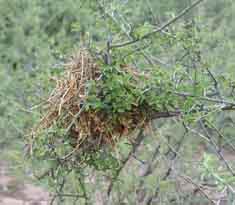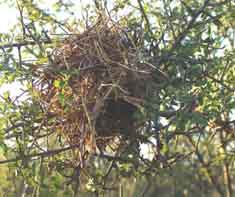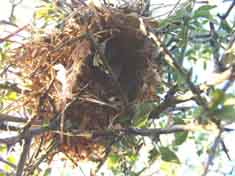Wrens, Bushtits, Titmice & Chickadees
Wrens are mostly small, brown, and active birds, who seclude themselves, creeping through vegetation looking for insects and fruit. They often move with their tails raised above their backs. They have long heads and long, slender bills for probing deep into crevices (Sibley 2000, p. 384).
Cactus Wren (Campliorhynchus brunneicapillus)
We have substantial numbers of cactus wrens in our area, but find them hard to photograph. This one below was patrolling Sierra Blanca Spring Wash in January 2006 as it paused, perching very briefly on an Ocotillo stalk. Despite the poor resolution of this photograph, the major distinguishing features are reasonably clear -- its long white supercilium (the arch of feathers above the eye), its long, slightly downcurved beak, the dark throat whose spots scatter out into the buff-colored belly, and the black-and-white-barred tail feathers. Our largest Wren, it is a bold, busy bird, searching for insects on ground, rocks, brush, and trees. These birds often weave their globular nests in the branches of Cholla cacti.

We photographed this pair of fledglings in poor light on April 27, 2008, but they too show the main features: dense, dark spots on the breast, the long bold supercilium, and the powerful, slightly curved bill. Click on the image to enlarge it.

Rock Wren (Salpinctus obsoletus)
This bird was photographed on a terrace in Lower Hot Springs Canyon on October 31, 2001. A farily large and long-billed bird, it prefers rock-piles for its habitats.

Bewick's Wren
Verdin (See Verdins et al.)
 .
. ,
,

Return to Birds